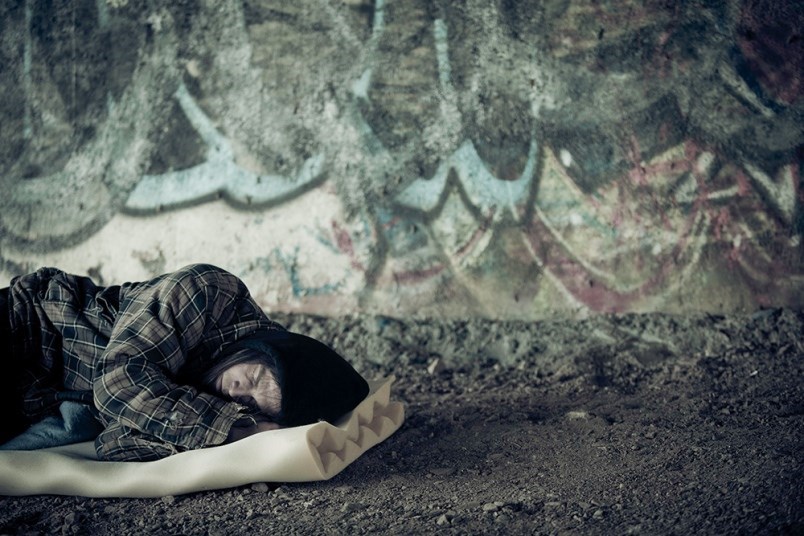Nearly two dozen unhoused people in New Westminster died of accidental deaths between 2012 and 2021 – the 13th highest count of all communities in B.C.
A newly released report, Deaths of Individuals Experiencing Homelessness in B.C. – 2012 to 2021, summarizes deaths of individuals that had been reported to the BC Coroners Service between Jan. 1, 2012 and Dec. 31, 2021. It showed that 23 unhoused people in New Westminster died during that timeframe.
“Service providers have known for years that people who are homeless are at much higher risk for health and other problems than those folks who are not. You can look at any health indicators and see this to be true,” said Lynda Fletcher-Gordon, interim executive director of the Lower Mainland Purpose Society for Youth and Families. “The evidence was there for all to see during the COVID pandemic. Homeless people who were positive for COVID, literally had nowhere to go. The value of this report is that it puts the reality of the person who is homeless front and centre.”
According to the report, there was an average of 120 deaths per year of individuals experiencing homelessness from 2012 to 2021.
Between 2012 and 2021, 248 unhoused people in Vancouver died of accidental deaths, followed by Surrey (127), Victoria (99), Abbotsford (66), Kelowna (54), Prince George (53), and Kamloops (43). Other B.C. cities experiencing a high death count among individuals experiencing homelessness were: Chilliwack (39); Nanaimo (30); Langley (25); Maple Ridge (25); Vernon (25); New Westminster (23); Burnaby (21); and North Vancouver (21).
Other B.C. townships reported a combined 298 deaths between 2012 and 2021.
In 2021, 247 people in B.C. who were experiencing homelessness died, which was a 75 per cent increase over the 141 deaths reported in 2020, stated the report.
BC Attorney General and Housing Minister Murray Rankin and Mental Health and Addictions Minister Sheila Malcolmson released a joint statement in response to the BC Coroners Service's report.
"Our heartfelt condolences go out to all of the families and friends of loved ones who have lost their lives while experiencing homelessness. The people who died were our neighbours, friends and family members, and our thoughts are with everyone grieving their loss,” said the statement. "Many of the people who died were men in the prime of their lives. At least 195 people experiencing homelessness died because of the poisoned illicit drug supply in 2021. Each death is a tragedy.”
The ministers said the data is a stark reminder of the devastating impacts the toxic drug crisis is having on people in B.C., compounded by the daily risks and health challenges faced by people experiencing homelessness.
“We are working on all fronts to turn the tide on this crisis, including expanding treatment services and harm-reduction measures like drug checking and prescribed safer supply, including for people experiencing homelessness,” said the statement. “We know that many people experiencing homelessness are dealing with both physical and mental health challenges that are difficult to resolve and treat without housing. That's why we continue to open new supportive housing and now, new complex care housing spaces for people who need an even higher level of support, for overlapping mental health and substance use challenges, trauma and/or acquired brain injuries.”
Some findings from the coroners report:
* Deaths occurred more often in the later months of the year, with November (11 per cent) having the highest proportion of deaths, followed by August and December (each with 10 per cent).
* 83 per cent of the people who died were male.
* People aged 30 to 59 accounted for 72 per cent of the deaths.
* By classification, 74 per cent of the deaths from 2012 to 2021 were considered accidental, followed by 13 per cent classified as natural and seven per cent as suicides.
* From 2012 to 2021, 87 per cent of all accidental deaths were suspected illicit drug toxicity deaths. (In 2021, the percentage of accidental illicit drug toxicity deaths among individuals experiencing homelessness was 93 per cent.)
For the report, a person experiencing homelessness was defined as someone: living outdoors, in a parked vehicle or another structure not intended for habitation; staying at a emergency shelter (overnight); being temporarily sheltered (suspected to be for less than 30 days) by friends or family, in a short-term shelter, temporary modular housing, safe house for youth or a transition house for someone and children fleeing violence. People who were residing in short-term shelters, safe houses or transition houses for an unknown length of time were also included in the report.
In July, city council endorsed in principle a new New Westminster Homelessness Action Strategy, a five-year vision and plan to address homelessness and related issues in the city. The strategy includes 46 actions grouped into five categories: coordination and partnership; shelter, housing and tenant supports; income, employment and financial literacy; services and supports; and communication engagement and involvement.
Fletcher-Gordon told the Record that people in New Westminster fortunate to live in a city where people are supportive of shelters and other forms of housing and where city council is working diligently to address the fact that, while there is not enough housing, what is available is priced out of a range that’s affordable to people on lower incomes or no incomes.
“From a fear of contracting COVID, we have moved to people fearing being evicted because finding affordable housing is a gargantuan task,” she said. “Homelessness is not new and it will take significant and ongoing work to address it. What we can do in the meantime is provide access to other services that will reduce the risks for people living on the street, e.g. food, appropriate clothing, access to showers and laundry, access to medical services, safe supply, and other support services.”


